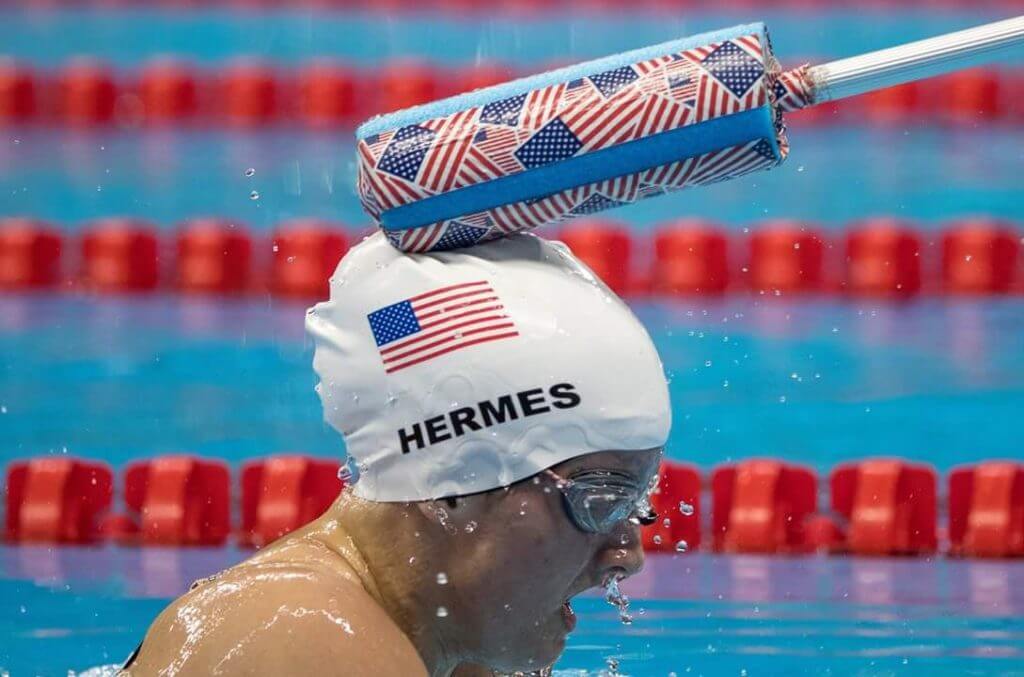The Art of Tapping for Visually Impaired Swimmers

The Art of Tapping for Visually Impaired Swimmers
For visually impaired and blind athletes, competing in swimming is predictably more complicated than it is for swimmers with sight. “Tappers” are the individuals who assist these swimmers during their transitions. Their name refers to the motion they make by tapping swimmers on the head or back with a pole to let them know when to turn. Though they play a crucial role in many Paralympic athletes’ performances, they’re not commonly seen in most swim settings.
History
Tappers are now a standard aspect of para-swimming, but they haven’t always been part of the sport. Before their introduction, visually impaired swimmers had to rely on stroke counting to know when to turn – a method that was often unreliable and took away from their ability to focus on racing.
The tapping system was developed in the 1970s and 1980s by Audrey and Wilfred Strom. They created it to help 28-time Paralympic medalist Tim McIsaac compete using flip turns. Audrey Strom played a key role in bringing the tapping system into official use through the Canadian Blind Sports Association and the International Blind Sports Federation.
Who Uses Tappers?
While the short answer is visually impaired swimmers, the use of tappers is specifically regulated under Paralympic classification guidelines. Athletes classified in the S/SB11 through S/SB13 categories are considered visually impaired, but only S/SB11 are required to use tappers during competitions, while the other two classifications have an option.
The Device
The tapper is generally a homemade tool designed for and by each swimmer. There is no standardized equipment for tapping. Some use canes with a soft ball or padding attached to the end, while some prefer a fishing pole sort of device. While designs vary, the only requirement is that all devices must be approved by the Paralympic Committee.
The Role of Tappers in Para Swimming
As previously noted, tappers play a key role in helping visually impaired swimmers compete safely and effectively. Typically, tappers are individuals close to the athlete, such as a coach or parent. They use the device to tap the swimmer as they approach the wall, signaling when to turn or finish. Tappers are positioned at each end of the lane for a swimmer.
Though their job may appear minor to the casual observer, the collaboration between a swimmer and their tapper is critical for performance. Perfecting the timing of a turn is difficult for any athlete. Even an extra stroke or being slightly off in distance from the wall can cost valuable time during a race. These fractions of a second can make a difference between winning and missing a qualifying cut. For visually impaired swimmers, this challenge is amplified.
The swimmer and tapper must be perfectly in sync. In an interview with the Paralympic website, Paralympic gold medalist Brad Snyder emphasized the importance of this relationship with his tapper.
“When we get on the same page, the turn should look exactly like an able-bodied swimmer’s turn,” Snyder said. “You shouldn’t even be able to tell that I’m blind.”
Techniques and Preferences
There is no universal method for tapping. Each swimmer and tapper collaboration may develop a custom strategy that suits the athlete’s preferences. For example, some swimmers prefer to be tapped on the head, while others, like Snyder, prefer being tapped on the back. The timing of the tap also varies. Some athletes want to be tapped several strokes out from the wall, while others prefer to be tapped just before turning.
In an interview with World Para Swimming, Snyder explained that he prefers a “tap-then-turn” approach to minimize mistakes. He also shared that he prefers to be tapped on the back, rather than his head or shoulder. Snyder’s tapper, Brian Loeffler, noted that once competition begins, swimmers are not allowed to verbally communicate with their tappers. For this reason, the tap must be firm and distinct.
“They would rather be struck hard and feel the tap,” Loeffler said. “Rather than question, ‘Oh, was that a tap or was that a bump on the lane line?’”
Each tapper and swimmer must find a strategy that best fits the swimmer’s racing style and technique. The ultimate goal remains the same for all pairs: maximizing performance and ensuring the athlete’s safety.
From custom devices to the precise timing, the tapper-swimmer partnership proves that the smallest moments can make the biggest difference for swimmers in the pool.




I get paid more than $120 to $130 per hour for working online. I heard about this job 3 months ago and after joining this i have earned easily $15k from this without having online working skills.
This is what I do…….www.best.work43.com
I get paid more than $120 to $130 per hour for working online. I heard about this job 3 months ago and after joining this i have earned easily $15k from this without having online working skills.
This is what I do……www.best.work43.com